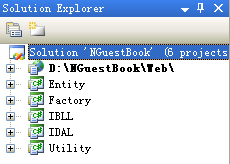基于.NET平台的分层架构实战(四)实体类的设计与实现_.Net教程
教程Tag:暂无Tag,欢迎添加,赚取U币!
推荐:基于.NET平台的分层架构实战(三)架构概要设计本文主要是对将要实现的架构进行一个总体的描述,使朋友们对这个架构有个宏观上的认识。这篇文章理论性的东西会偏多一点,从下篇开始,将进行实际项目的开发。这篇文章的许多内容摘自我的毕业论
实体类是现实实体在计算机中的表示。它贯穿于整个架构,负担着在各层次及模块间传递数据的职责。一般来说,实体类可以分为“贫血实体类”和“充血实体类”,前者仅仅保存实体的属性,而后者还包含一些实体间的关系与逻辑。我们在这个Demo中用的实体类将是“贫血实体类”。大多情况下,实体类和数据库中的表(这里指实体表,不包括表示多对多对应的关系表)是一一对应的,但这并不是一个限制,在复杂的数据库设计中,有可能出现一个实体类对应多个表,或者交叉对应的情况。在本文的Demo中,实体类和表是一一对应的,并且实体类中的属性和表中的字段也是对应的。
在看实体类的代码前,先看一下系统的工程结构。

如上图所示,在初始阶段,整个系统包括6个工程,它们的职责是这样的:
Web——表示层
Entity——存放实体类
Factory——存放和依赖注入及IoC相关的类
IBLL——存放业务逻辑层接口族
IDAL——存放数据访问层接口族
Utility——存放各种工具类及辅助类
这只是一个初期架构,主要是将整个系统搭一个框架,在后续开发中,将会有其他工程被陆陆续续添加进来。
我们的实体类将放在Entity工程下,这里包括三个文件:AdminInfo.cs,MessageInfo.cs,CommentInfo.cs,分别是管理员实体类、留言实体类和评论实体类。具体代码如下:
AdminInfo.cs:
AdminInfo
1using System;
2
3namespace NGuestBook.Entity
4{
5 /**//// <summary>
6 /// 实体类-管理员
7 /// </summary>
8 [Serializable]
9 public class AdminInfo
10 {
11 private int id;
12 private string name;
13 private string password;
14
15 public int ID
16 {
17 get { return this.id; }
18 set { this.id = value; }
19 }
20
21 public string Name
22 {
23 get { return this.name; }
24 set { this.name = value; }
25 }
26
27 public string Password
28 {
29 get { return this.password; }
30 set { this.password = value; }
31 }
32 }
33}
34
MessageInfo.cs:
MessageInfo
1using System;
2
3namespace NGuestBook.Entity
4{
5 /**//// <summary>
6 /// 实体类-留言
7 /// </summary>
8 [Serializable]
9 public class MessageInfo
10 {
11 private int id;
12 private string guestName;
13 private string guestEmail;
14 private string content;
15 private DateTime time;
16 private string reply;
17 private string isPass;
18
19 public int ID
20 {
21 get { return this.id; }
22 set { this.id = value; }
23 }
24
25 public string GuestName
26 {
27 get { return this.guestName; }
28 set { this.guestName = value; }
29 }
30
31 public string GuestEmail
32 {
33 get { return this.guestEmail; }
34 set { this.guestEmail = value; }
35 }
36
37 public string Content
38 {
39 get { return this.content; }
40 set { this.content = value; }
41 }
42
43 public DateTime Time
44 {
45 get { return this.time; }
46 set { this.time = value; }
47 }
48
49 public string Reply
50 {
51 get { return this.reply; }
52 set { this.reply = value; }
53 }
54
55 public string IsPass
56 {
57 get { return this.isPass; }
58 set { this.isPass = value; }
59 }
60 }
61}
62
CommentInfo.cs:
CommentInfo
1using System;
2
3namespace NGuestBook.Entity
4{
5 /**//// <summary>
6 /// 实体类-评论
7 /// </summary>
8 [Serializable]
9 public class CommentInfo
10 {
11 private int id;
12 private string content;
13 private DateTime time;
14 private int message;
15
16 public int ID
17 {
18 get { return this.id; }
19 set { this.id = value; }
20 }
21
22 public string Content
23 {
24 get { return this.content; }
25 set { this.content = value; }
26 }
27
28 public DateTime Time
29 {
30 get { return this.time; }
31 set { this.time = value; }
32 }
33
34 public int Message
35 {
36 get { return this.message; }
37 set { this.message = value; }
38 }
39 }
40}
41
大家可以看出,实体类的代码很简单,仅仅是负责实体的表示和数据的传递,不包含任何逻辑性内容。
分享:基于.NET平台的分层架构实战(二)需求分析与数据库设计在实际的项目中,需求分析和数据库的设计是很重要的一个环节,这个环节会直接影响项目的开发过程和质量。实际中,这个环节不但需要系统分析师、软件工程师等计算机方面的专家,还需要相关领域的
相关.Net教程:
- asp.net如何得到GRIDVIEW中某行某列值的方法
- .net SMTP发送Email实例(可带附件)
- js实现广告漂浮效果的小例子
- asp.net Repeater 数据绑定的具体实现
- Asp.Net 无刷新文件上传并显示进度条的实现方法及思路
- Asp.net获取客户端IP常见代码存在的伪造IP问题探讨
- VS2010 水晶报表的使用方法
- ASP.NET中操作SQL数据库(连接字符串的配置及获取)
- asp.net页面传值测试实例代码
- DataGridView - DataGridViewCheckBoxCell的使用介绍
- asp.net中javascript的引用(直接引入和间接引入)
- 三层+存储过程实现分页示例代码
- 相关链接:
- 教程说明:
.Net教程-基于.NET平台的分层架构实战(四)实体类的设计与实现
 。
。